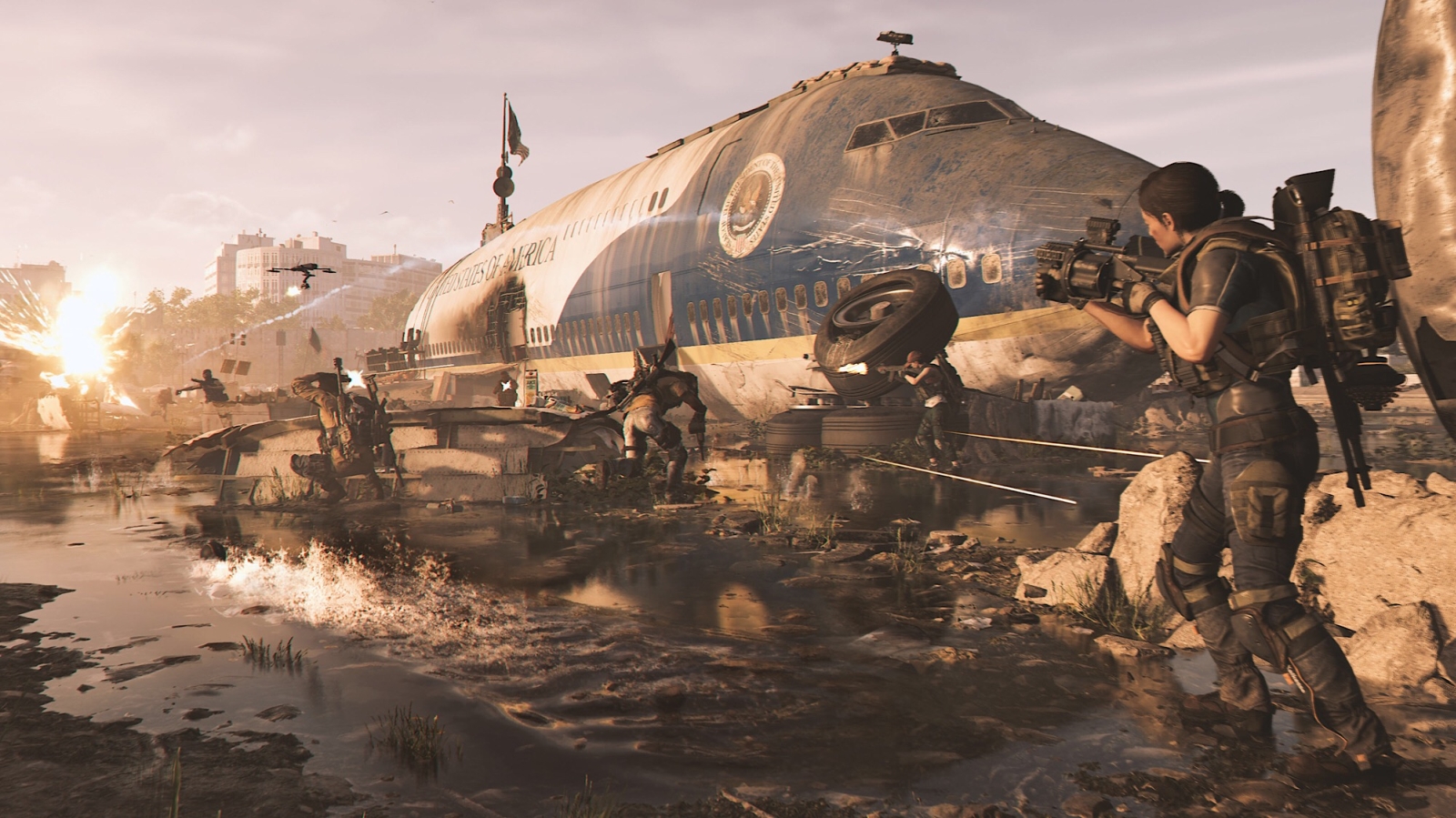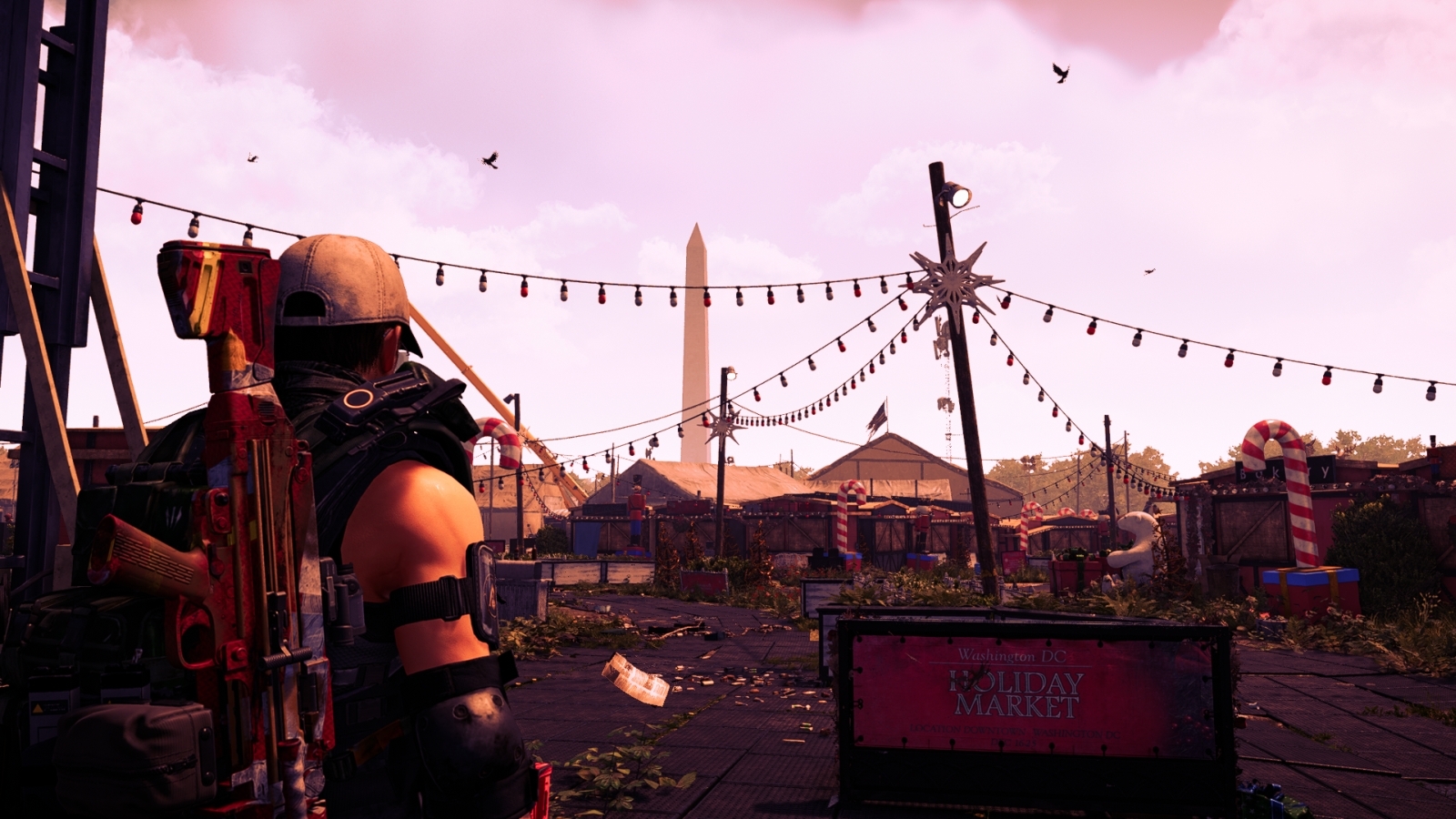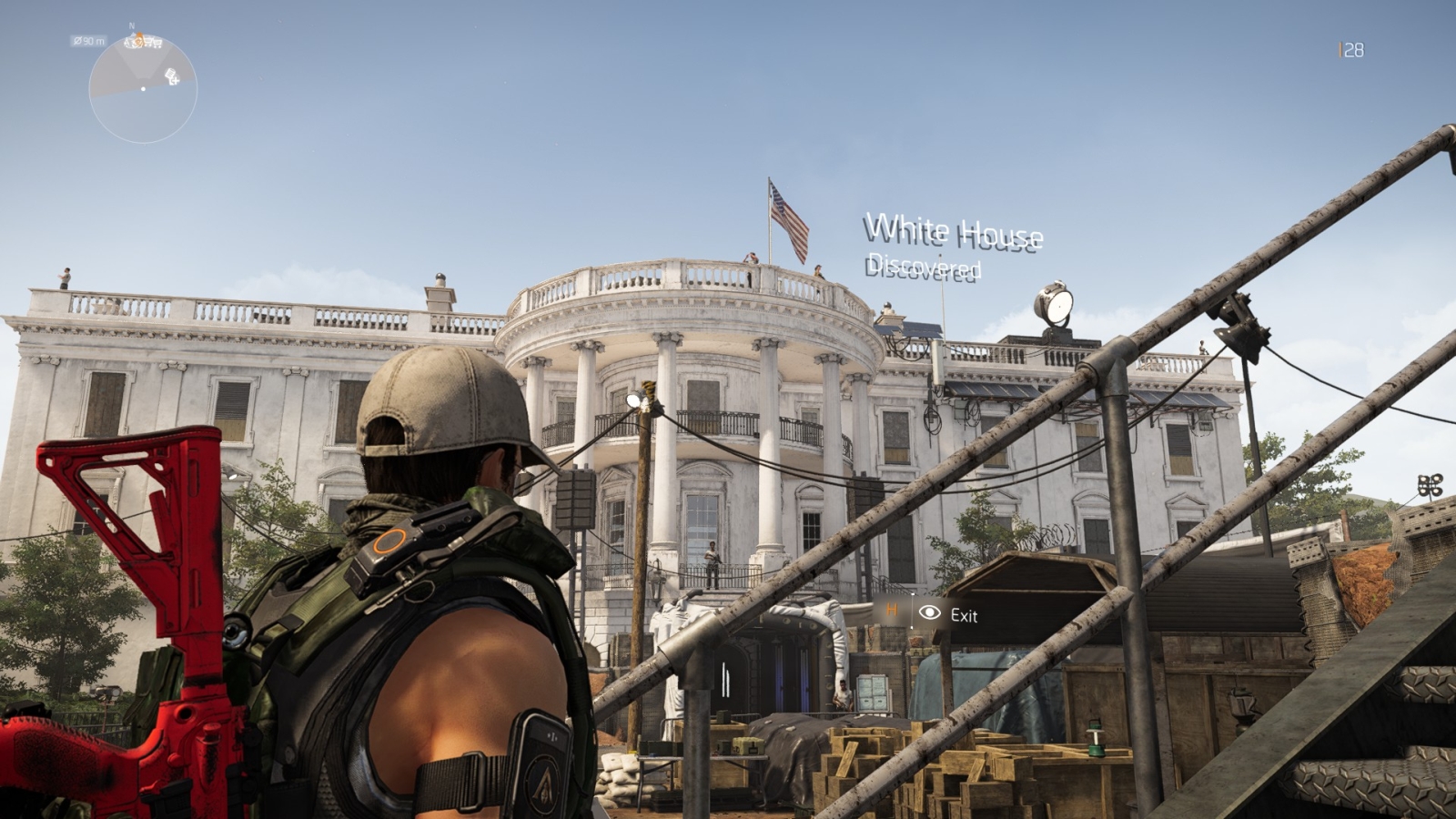
If you want a roadmap of how to go from good to great, you don’t have to look much further than Ubisoft and Massive Entertainment’s The Division. The game launched with solid footing, but endgame content was a bit thin, and mission repetition and bugs held it back at launch. Over the next three years, Massive went into overdrive delivering tons of free updates, six major expansion packs, and innumerable quality of life improvements. It set the stage for the sequel nicely, so I was eager to re-activate and set off to D.C. to fight terror once again.
For those who might need a refresher, The Division tells the story of an outbreak called “The Green Poison.” A smallpox outbreak transmitted by physical money trading hands on Black Friday of 2015, the virus swept through New York City, unleashing chaos and destruction across the island of Manhattan. The government quarantined the island, but the damage was done.
The Division 2 takes place seven months after the events of the first game. The quarantine was ineffective, spreading all the way to Washington D.C. With the nation’s capital under siege, agents of the The Division are re-activated. After a short siege on the White House, we learn that the vast majority of the executive branch is dead, and that the virus has all but burned itself out, leaving behind a far worse threat — a city full of desperate survivors and a dangerous and far expanded criminal element hellbent on making a bad situation far worse.

Bad things are afoot in Washington D.C.
Looter shooter sequels are a tricky war of escalation, but it seems that Massive is taking a different tactic than others. Many games launch their sequel in a “slightly better than the first” state, retreading their previous roadmap by re-adding features that were cut to launch the new game. The Division 2 instead launches with every feature baked into the three years of updates received by its predecessor, and already has a full year’s worth of content on the horizon.
One of the things I appreciate most deeply about The Division 2 is the pacing. Not unlike Assassin’s Creed Odyssey, the game’s areas are divided by level, but as your level increases, the game dynamically scales upwards as well. Rather than just upping the damage output and enemy HP-sponge factor, the developers also used this as an opportunity to slowly phase in the game’s various factions and enemy types. Early areas will have you dealing with basic gunners who are ill-equipped and frankly just wandering opportunists. As you slowly free the various areas of D.C. from the grip of these looters and domestic terrorists, you’ll start encountering grenadiers, snipers, tougher lieutenants, armored melee troops, heavy gunners, guys that spray adhesive goo that roots you to the ground, ones wielding flamethrowers, and eventually troops that can use the same gadgets you do. Frankly, the shield is an amazing bulwark against incoming fire, but facing it on the other end of the battlefield creates a whole different challenge. In this way, the team created a game that grows with your skill level, instead of simply adding additional digits to a health and armor stat. This helps alleviate the complaints that the first title launched with around enemy variety and enemies taking too long to take down, and as a result, the game is infinitely more engaging.

Retaking the capital is your first objective — it starts The Division 2 with a bang.
Massive Entertainment and Ubisoft Red Storm have broken the mold on the cover-based shooter with extensive efforts around the brains of their AI. The enemy is as relentless as they are numerous, and they use that to flank, press, and otherwise shove you out of your safe spaces and into danger. Grenadiers will kick you out of cover with molotovs and grenades, and runners will amp up on drugs and rush up to your position to beat you with an asp baton. Flamethrower-wielding enemies will simply set your world on fire. While a lot of cover-based shooters are comfortable with making the player all but invulnerable while behind an object, The Division 2 looks for all of the ways they can push the player to shoot and scoot.
There is also an improvement in the core gameplay loop that cohesively binds the narrative and gameplay together — settlements. It’s all but part of the Ubisoft DNA, but part of opening up the map in The Division 2 is unlocking safe houses and freeing enemy-seized settlements. Once you approach a settlement, you can launch a flare to signal freedom fighters to rush in to help you retake the control point or settlement. Capturing control points gives you additional fast travel options, but more importantly it starts to retake that sector of the city. You’ll find fewer enemy patrols out gathering resources or publicly executing civilians, instead encountering ragtag survivors out to collect water or scraps to bring back to base.

All of the landmarks of DC are present and accounted for.
Having AI-powered friends and foes roaming about makes the world of The Division 2 delightfully unpredictable. There’s as much chance of friendlies dropping in to back you up during a control point siege as there is enemies pincering you from both sides. Similarly, not keeping your head on a swivel can cause you to run into an elite looting bodies who can drop you in a single hammer swing.
While it is possible to play a good deal of The Division 2 solo (though it is much, much harder), the game was built to experience with friends. When patrolling the streets alone, if you find yourself jammed up you can mash the “Looking for backup” button which will call other players into your game, should they answer the call. This drop-in / drop-out system is sleek and elegant, allowing players to request as little or as much help as they want. The Division 2 supports up to four players in a fireteam for the vast majority of the game, but upcoming raid content promises up to eight players duking it out, leaving those who have rushed to the end a fresh gameplay mode to look forward to.
One of the best parts of the worldbuilding of The Division 2 is its incredible potential to distract you. On more than one occasion our fire team was on our way to pick up a SHD Tech Cache (the collectable that helps you unlock new drones, explosives, perks, and more) only to find ourselves far off course to help stop an execution, which led to freeing a nearby control point, which pulled us into a supply drop defense objective. There is so much to do, and all of it compelling, which kept bringing my fireteam coming back to the game again and again.

Each area in D.C. needs your help, but will reward you for your efforts.
Mechanically, the game supports multiplayer matchmaking in a robust way. The Division 2 supports in-game voice, and a full text chat system, though occasionally my fireteam ran into issues with invites. Once everything syncs up, the load time to join another player’s game is quick, and fast travel reduces the wandering around to keep players in the fight. There are a few items that could be improved, but they are fairly minor. Wayfinding doesn’t set the same waypoint for other players, so pickup groups are often not as organized as they could be. Similarly, Clans (could we have not called them Guilds? I have a hard time encouraging people to “join the clan”) could use a bulletin board instead of the single message “notification” system currently in place as it would allow better coordination of stronghold-focused nights.
At launch, the game had frequent and frustrating client crashes and bugs with turret use. The turret issues have been resolved, and crashes have been reduced, but unfortunately have not been eliminated. Havok-based physics bugs are hilarious, but do break immersion. We had one mission that ended with the hostage we were rescuing floating up in the air like superman embodying the “I must go, my people need me!” meme perfectly. While all of these will be ironed out over time, it is the current state of the game. Here’s a quick dance from Holly (her legs are very flexible), and a bounty target that is very excited to be selected.
We did run into some severe scaling issues early on during our time with The Division 2. While the game handles a few levels of discrepancy very well, we had one evening where every battle was something beyond ridiculous. David had rushed ahead and was nearly level 30, I was level 8, and Holly and Laura were level 3 and 6, respectively. The scaling system kicked in, pushing all of our stats and levels up to where David’s character was, but our weapons lacked the punch to do much, leaving David to carry the team. As our levels got closer, and our gear more closely matched, this issue subsided, but spending nearly three hours trying to kill a mortar-launching named boss makes me think the scaling system isn’t working as well as intended in its current state.
While bag management is a part of any looter-shooter, deconstructing items still feels a bit undervalued in The Division 2. Breaking down your weapons and armor yields crafting components you can turn into modifications for your equipment. Completing side missions and objectives unlocks access to, as an example, foregrips that improve accuracy, but lower weapon stability. The hitch is that there’s very little to craft, and what’s there isn’t all that useful until closer to the endgame. This is an area that I’d like to see vastly expanded.

There is PLENTY of loot in The Division 2. No problems in that department.
One of the best endorsements for The Division 2 is the way it has snared two of our editors, Holly, and my wife Laura. Neither of them are huge fans of third person cover-based shooters, but after only a short while with the game, both were inexorably hooked. Laura, a complete shooter rookie, has become a steely-eyed sniper and moved from a controller to mouse and keyboard.
Other looter shooters have fallen a bit short on storyline, and the original Division title suffered a bit in this department as well. The Division 2 features a huge raft of side missions, optional activities, and main missions. Ultimately most of these, as you might expect, are all-out battles punctuated by a boss, but the scenery changes often enough to keep you on your toes. Sometimes your firefight takes place in a cramped office building, and other times you’ll find yourself with a lot of ground to cover taking on enemies across a large construction yard. It means that your tactics, and ultimately your weapon selection, likely need to change often to match the battle around you. The main story arc will take roughly 40 hours to complete, but that isn’t, in fact, the end of the game.

There are a bunch of things to do around D.C.
Once you hit level 30 you’ll be given the opportunity to pick a specialization. Currently (Massive has already announced additional specializations on its roadmap) you can be a sharpshooter (read: sniper), survivalist (read: crossbow-wielding generalist), or demolitionist (read: grenadier), which unlocks special weapons for each class. You aren’t in any way locked to a particular path, but each one unlocks a huge list of modifiers that can help you become more effective in the field. These can be additional headshot damage, faster reload speeds, increased armor while in cover, incendiary grenades, burn resistance, and much more.
Beyond specializations are five levels of “World Tier” — the true endgame. Once you’ve hit level 30 and completed all three strongholds you’ll be ranked “World Tier 1”. Getting better loot means taking on a brand new faction. These factions will take steps to push back Agents of the Division, forcing you to do battle with them in the strongholds once again. Better and better gear leads to a higher “Gear Score”, moving you from World Tier 2 to 3, and 4. Getting to Tier 5 means waiting a little bit as the “Tidal Basin” isn’t released as of yet. It provides players with fresh opportunities and battles to revisit in addition to the secondary difficulty levels for missions.

Cover is your friend, but the odds are not in your favor.
For those of you who want to tangle with people in a PvP environment, the Dark Zones have returned with a few twists. There are now three Dark Zones available for players to scrap it out for random and contaminated loot. If you need a refresher, Dark Zones are the portions of the game where players can encounter more dangerous foes, as well as other players — in short, PvEvP. Thematically, it was the epicenter of the outbreak, standing as a monument to the failed attempt to lock the virus into a quarantined area. Players that ventured into the space would find contaminated gear that they had to shepherd past AI enemies and other players alike to reach designated drop zones. Once there, they’d fire a signal flare and start a short countdown. This countdown was essentially a dinner bell for everyone in the zone — they now know that you are trying to cart something valuable out of the area, and they just might like to take that for themselves. Even friends that helped you push through those tough parts of the zone might suddenly like the shiny new gun more than they like you — nobody is safe in the Dark Zone.
Dark Zone East is a wide open space full of long open sight lines — perfect for the longrifle fans in your team. Dark Zone South is choked with vegetation, with large interiors, tight corridors, and plenty of close combat. It is the space where the sick were initially sent when things went sideways, so it’s also the place largest hit. The third zone, Dark Zone West (creatively named, I know) is comprised of homes, apartments, alleys, and a whole lot of medium range combat. It’s also the testing ground for DC-62 — the compound that was meant to destroy the disease, which, naturally made it much worse.

Rebuilding the White House as Division HQ
Beyond the mechanical changes, there’s also a new gameplay loop called Rogue. With an emphasis on theft and greed, the Rogue system allows players a new choice when they encounter locked boxes in the Dark Zone. In The Division, when you found a box that wasn’t yours, your only option was to keep on walking. Now, you can bash the lock and share it with everyone around you…that, or you can, of course, steal it all for yourself. Either way, it wasn’t yours, so now you’ve gone rogue. Being in a rogue state means you are now vulnerable to attack from everyone in the zone. Fighting back only worsens the situation, making you a disavowed rogue. Killing those hunting you is the deepest cut of all, alerting everyone that you are fair game and making your status “manhunt rogue”. It creates a progressive escalation loop that further fleshes out the Dark Zones with shades of grey besides simply betraying your friends.
The last major change is easily the most controversial, but the one I feel is the most needed. To ensure the most fair and equitable experience when players do encounter each other, all but the final endgame Dark Zone (referred to as an “Occupied Dark Zone, where friendly fire is on at all times) is normalized. This means that the stats between weapons, regardless of rarity, are normalized to ensure that it is player skill, not equipment, that determines the outcome.

“Join the clan” just doesn’t have the right sound.
Ultimately, the Dark Zone, like any other “game as a service” object, is a vehicle in motion. Currently, the Dark Zone gear doesn’t seem to be materially different than the random junk I find in the various backpacks, luggage, and boxes strewn around D.C. That said, the game is more than complete even without the Dark Zones, so these spaces remain a good place to duke it out with or against friends while still moving the bar forward. It’ll be great to see these improve over time, and the last three years worth of track record tells me that it will.
Your Division Agents:
Ron Burke
Laura Burke
Holly Hudspeth
David Hudspeth
Tom Clancy's The Division 2
Excellent
With an incredibly robust feature set and massive swaths of content ready for the launch window, as well as an extensive roadmap on the horizon, The Division 2 raises the bar for how a sequel should launch. Only a handful of minor bugs and hiccups remain, but none of them hold this back from being the best team-based shooter we’ve played in a very long time. Massive Entertainment has a massive hit on their hands, and we can’t wait to see where it goes next.
Pros
- Compelling and engaging combat
- Four-player multiplayer is addictive
- Loot variety is vast and rewarding
- Overall enemy “sponginess” is greatly improved
- Excellent world building and mission variety
Cons
- Havok bugs remain
- Dark Zone loot feels light on risk/reward
- Level scaling with large discrepancies seems unbalanced
